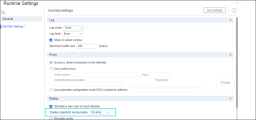LoadRunner Developer tests
This topic describes how to use DevWeb scripts in LoadRunner Enterprise performance tests. LoadRunner Developer scripts are created in LoadRunner Developer or the DevWeb protocol in VuGen.
In this topic:
- LoadRunner Developer tests overview
- Add LoadRunner Developer scripts to performance tests
- LoadRunner Developer snapshots
- Known issues for DevWeb scripts
LoadRunner Developer tests overview
LoadRunner Developer is OpenText's latest cutting-edge tool for web protocol performance and load testing. LoadRunner Developer uses a new, innovative JavaScript SDK and engine that focus on the HTTP transport level and WebSocket traffic.
By including LoadRunner Developer scripts in your LoadRunner Enterprise tests, you can run LoadRunner Developer tests side-by-side with any other tests, giving you a single entry point for running your performance tests.
Measurements can be viewed online and offline in LoadRunner Enterprise and Analysis, using the data points from the LoadRunner Developer tests.
Add LoadRunner Developer scripts to performance tests
This task describes how to add LoadRunner Developer scripts to performance tests, for DevWeb scripts created in either VuGen or DevWeb Standalone.
-
-
Create scripts in LoadRunner Developer and save the scripts locally. The scripts must be compressed directly and not from a folder, otherwise they fail to upload to LoadRunner Enterprise.
In Windows Explorer, highlight all the scripts, right-click and, from the context menu, select Send to > Compressed (zipped) folder.
If you have 7zip, you can compress files directly from command line as described below (where script files are under the "2020_features" folder, and the output zip is "3.zip"):
C:\Program Files\7-Zip>7z.exe a C:\Users\John\Downloads\2020_features\3.zip C:\Users\John\Downloads\2020_features\*
Note: The file path inside a script folder must not exceed 260 characters.
-
We recommend that you delete any old or unnecessary files from the scripts folder to avoid them being uploaded to LoadRunner Enterprise.
-
-
Upload LoadRunner Developer scripts to LoadRunner Enterprise
For details, see Upload a script to LoadRunner Enterprise.
Note: When uploading LoadRunner Developer scripts to LoadRunner Enterprise, make sure the scripts include all the relevant files, such as parameters and additional JavaScript in the runtime files.
After uploading the script to LoadRunner Enterprise, the script is added to the test management tree. You can view and edit most scripts directly from within the LoadRunner Enterprise user interface. For details, see Edit a script.
-
(Optional) Edit the script parameters
After you have uploaded a LoadRunner Developer script to LoadRunner Enterprise, you can edit the script parameters. For details, see Edit script parameters.
-
Create a LoadRunner Enterprise test, and assign the LoadRunner Developer script to it.
For details, see Design a test.
-
(Optional) Configure runtime settings
Before you run a performance test, you can view and configure the behavior of the Vuser scripts in the test using runtime settings. For details, see Configure runtime settings.
For details on runtime settings for LoadRunner Developer scripts, see the LoadRunner Developer and DevWeb Help Center.
-
Run the test.
For details, see Manage a performance test run.
Data points from LoadRunner Developer tests are displayed in Web resources graphs in LoadRunner Enterprise. For details, see Web resource monitor graphs
LoadRunner Developer snapshots
Snapshots contain the data generated by the traffic between the client and the server, and are captured when a script is replayed. LoadRunner Developer script snapshots display all HAR data associated with a specific web request step in the script.
You can configure snapshot settings for each Vuser group that has a LoadRunner Developer script assigned to it. By default, LoadRunner Developer scripts are set to take snapshots only for errors that occurred during the replay of a script.
Change snapshot settings for a Vuser group
-
In the top banner, click the module name or the dropdown arrow and select Test Management > Tests & Scripts.
-
In the test management tree, select the performance test and click Edit Test.
-
In the Groups and Workload view, for each Vuser group that has a LoadRunner Developer script assigned to it, select the Vuser group for the DevWeb script that you want to change, and click the Edit Runtime Settings button
 . The Edit Runtime Settings dialog box opens.
. The Edit Runtime Settings dialog box opens. -
Open the General > DevWeb Settings > Replay node.
-
In the Create snapshot during replay option, select the snapshot option:
-
On error. Creates snapshots only for errors that occurred during the replay of a script (the default setting).
-
Always. Always create snapshots during replay.
-
Never. Deactivates the snapshot feature.
-
For details, see DevWeb runtime settings.
View LoadRunner Developer snapshots
DevWeb script snapshots display all HAR data associated with a specific web request step in the script.
To view DevWeb script snapshots:
-
During a performance test run, open a test that is running with a DevWeb script, and click Vusers Details. The Vusers dialog box opens. For details, see View Vuser details.
-
Click the Snapshot button
 in the Vuser dialog box to download a zip file with the HAR files.
in the Vuser dialog box to download a zip file with the HAR files. -
Extract the files and open the HAR files in a text editor or HAR file viewer of your choice.
Known issues for DevWeb scripts
-
Rendezvous points are not displayed in LoadRunner Enterprise for DevWeb standalone scripts (standalone scripts are generated by the DevWeb tool, and not by VuGen).
-
When creating a new test with a DevWeb script using a REST API and you provide Runtime Setting values, the script's Runtime Settings for this group are used instead of those provided in the body of the REST API request. For details, see Runtime Settings XML in the LoadRunner Enterprise REST API.
 See also:
See also:











